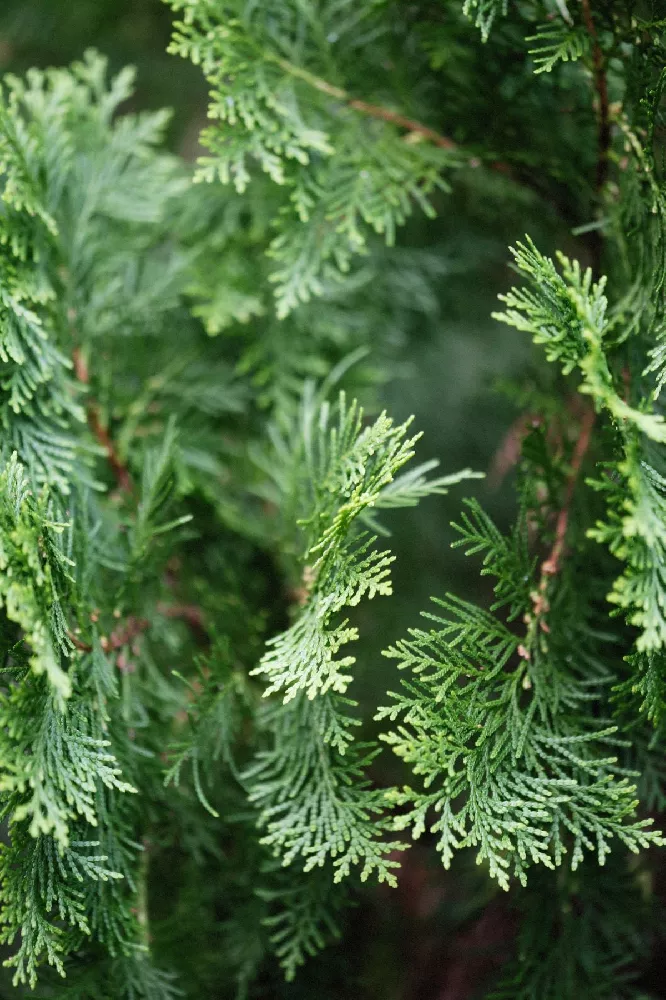- Home >
- Evergreen Trees >
- Berckmans Gold Arborvitae
Berckmans Gold Arborvitae for Sale - Buying & Growing Guide
While the Berckmans gold arborvitae is on the smaller side compared to other arborvitaes, that does not mean that this species can't make an impact on your garden's overall visual appeal. Instead, this cultivar, Thuja orientalis 'Berckmans Gold,' has bright, gold-tinted foliage that stands out compared to the foliage of most other popular evergreens. The Berckmans gold arborvitae is also adaptable to varying degrees of sunlight while maintaining a neat shape throughout its life.
- The Berckmans gold arborvitae has gold-tinted foliage.
- The overall form of this plant is narrow, neat and conical.
- Unlike other arborvitaes, this one grows well in full sun and partial shade.
Enter your zip code to find nearby stores that may carry this plant.
Plant Care
Sunlight

The Berckmans Gold Arborvitae can grow in both full sunlight and partial shade.
Watering
This plant has great drought tolerance when mature. Water about once per week during establishment.
Fertilizing

Fertilize once per year or not at all.
Planting and Care
Planting instructions
To plant your Berckmans gold arborvitae, remove the plant from its current container and observe its root ball. Loosen any tangled roots on the outside of the root ball and dig a hole that is as deep as the root ball is tall and about twice as wide. Place the plant in the hole and ensure that its main stem is vertical. If you plant multiple Berckmans gold arborvitaes, you should give each one about 3 feet of space.
Watering and nutrients
Although this plant needs water on a weekly basis during the first few growing seasons, you won’t need to water it much at all once it is mature. The Berckmans gold arborvitae has great drought tolerance and will only need supplemental watering when there has been a prolonged period of drought or a long heatwave. Your Berckmans gold arborvitae will also grow just fine without fertilization. If you choose to fertilize, you should do so with a balanced mix during the early spring.
Pollination
Pollination for Berckmans gold arborvitae is rarely a concern for those who grow this plant, and it often takes place without you even noticing. Like all arborvitaes and many other evergreen species, the Berckmans gold arborvitae is a cone-bearing plant that relies on the wind to carry its pollen rather than pollinator insects or bird species. When pollination is successful, the Berckmans gold arborvitae will produce a set of brown cones that hold its seeds.
Pruning
In many cases, it is not necessary to prune a Berckmans gold arborvitae tree. This plant remains small and develops a neat conical form without the need for shaping and trimming. In fact, if you do choose to prune this plant, you should do so minimally. Arborvitaes do not sprout new growth from old wood, which means that cutting this plant’s foliage too far back can lead to permanent bare patches. Any pruning you choose to perform should take place during the spring.
Pests, diseases and animals
The Berckmans gold arborvitae can have problems with pests and diseases that are generally common among most arborvitaes. In the case of pests, scale insects, bagworms and spider mites are some of the most common insects that will cause an infestation. Regarding disease, leaf blight, tip blight and other fungal infections are common. Root rot can also arise in this plant, which, like the previously mentioned diseases, is often the result of excessive moisture. The use of unclean pruning tools can also transfer disease to this plant.
Achieving maximum results
The overall size of the Berckmans gold arborvitae can be surprising to some. On the one hand, some view this plant as a dwarf, when in actuality, it can grow to be as tall as 15 feet in some cases. Others expect this plant to grow just as large as any other arborvitae, which is not the case and detracts somewhat from the Berckmans gold arborvitae’s ability to provide privacy. Also, if you notice that your plant’s golden foliage begins to fade to green during summer, know that this is normal and not likely a sign of poor health.
FAQs
How fast does the Berckmans gold arborvitae grow?
The Berckmans gold arborvitae is a fast-growing plant that can increase its size by about one to 2 feet each year when proper growing conditions are in place. However, you should not worry about this plant overtaking your garden. While Berckmans gold arborvitae is fast-growing, it is still a relatively small- to medium-sized plant that has a neat form throughout its life. At maturity, this plant will be 15 feet tall at most with a neat conical shape.
Where does the Berckmans gold arborvitae come from?
The parent species of the Berckmans gold arborvitae is called Thuja orientalis and comes from Asia. This species has undergone a lot of cultivation throughout its history, which has led to many varieties, including the Berckmans gold arborvitae. While cultivation of this specific variety likely occurred in China, the name of this plant comes from Prosper J. Berckmans, a Belgian-born American nurseryman who brought this plant into prominence during the 1800s.
Why are my Berckmans gold arborvitae's leaves turning brown?
While your Berckmans gold arborvitae's foliage may fade from gold to green during the growing season, it should not turn brown at any point. If your plant's leaves begin to turn brown, it is not a good sign. Browning foliage typically arises from a lack of sunlight or overwatering. Also infestations of spider mites can also lead to foliage discoloration.
Compare Similar Products
You can't add more Product Name - Product size to the cart.
OK









